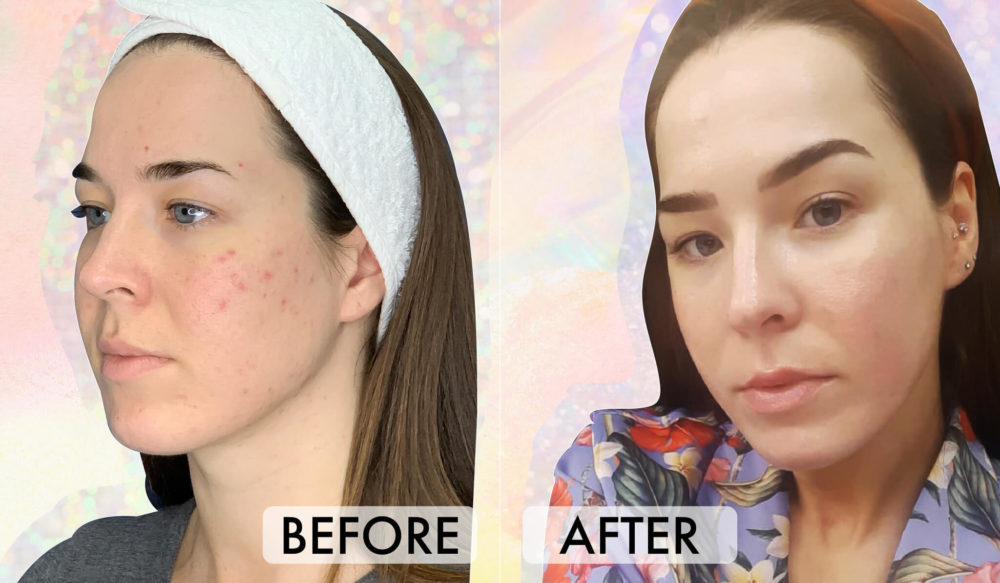Battle Of The Skincare Routines: Skin Boosting Vs. Skin Cycling
 via Giphy
via Giphy
No doubt you heard about skin cycling, a concept coined by Dr. Whitney Bowe that involves a four-day rotation of exfoliating, retinol, and recovery. It made quite a splash and upended skincare routines across the globe as people adopted this new way of slathering.
A brand new skin routine is making the TikTok rounds, though, and it’s in direct response to skin cycling. Yep, we’re talking about skin boosting, which some skincare experts say might actually be better for your complexion in the long run. At a crossroads? We’ve got answers.
What is Skin Boosting?
Long story short, skin boosting regimens are all about consistency and involve using the same treatment products daily with potencies that are strong enough to work but won’t cause irritation. From there, you can incorporate “boosters” into your regimen for an extra punch, like a targeted pimple treatment or a stronger retinol.
@drdennisgross Replying to @sephora What if instead of #skincycling you started ✨skin boosting✨ in your routine? Hear what Dr. Dennis Gross says about skin boosting + why he prefers it! 🧑🏻⚕️#drdennisgrossskincare #skinboosting #dermatologist #dermtiktok #dermatology #derm #skincaretiktok ♬ original sound – Dr. Dennis Gross
“The idea here is – unlike skin cycling where you give your skin a day or two off of actives – you rather consistently give your skin all the high-performing ingredients it needs and then boost it a couple of times a week,” says Jennifer Adell, a licensed esthetician. She adds, “The benefits are more consistent cell turnover with accelerated results.”
Dr. Jodi Logerfo, a family nurse practitioner certified in dermatology, agrees. She adds, “Skin boosting is an idea of keeping up with a normal skincare routine most days of the week and then intensifying the usual schedule by utilizing ingredients or products that are stronger two to three times a week.” Ultimately, getting our skin to a place where we can maximize active ingredients is the end goal, and skin boosting helps with that.
 via Giphy
via Giphy
Skin Boosting Regimen Examples
OK, so what does skin boosting look like in real life? Here are some real-world examples to help you wrap your head around the idea:
- Retinol Boost: In the evening, use your cleanser, toner, a serum of choice, and gentle retinol, followed by your moisturizer. “With skin boosting, you would use a stronger retinol or a peel pad with retinol in it to accelerate your results two to three times per week,” says Addell.
- TCA Peel Boost: “In our practice, we use TCA peels (trichloroacetic acid) at 5% two nights a week. This is a type of peel we use clinically in our office, but at a lesser strength you can do at home to boost up your regular skincare routine,” says Dr. Logerfo.
- Multi-Approach: “My skin boosting regimen in the morning is a gentle AHA wash, vitamin C serum, growth factor serum, peptide serum, defensins, and sunscreen,” says Dr. Jessie Cheung, board-certified dermatologist. “My PM regimen is a bakuchiol serum, growth factors, peptides, and defensins. I also use prescription strength retinoids one to two times a week at night, a chemical peel pad on Sundays, and will add a hydrating mask as needed.”
Obviously, each person’s routine should be catered to their needs, their skin type, and their specific complexion goals.
Posts You'll Love:
Is Skin Boosting too Aggressive?
 via Giphy
via Giphy
The appeal of skin cycling is that it’s so gentle on your skin. That begs the question of whether skin boosting could send your dermis into freakout mode. The experts we spoke to said that while there’s some potential to go overboard with skin boosting, it’s ultimately a matter of paying attention to your skin. Also, you need to keep in mind that the skin is apt to go through adjustment periods, especially when beginning retinol or acids.
“If you’re going to apply a product, make it work for you,” says Dr. Cheung. “Why bother using anything but actives? Actives don’t have to be irritating. On the contrary, they will nourish and maintain your skin barrier.”
Since you’re using the stronger products less often – but still applying them in lower amounts consistently through the week – your skin is more likely to tolerate greater strengths. That means you’ll get a better return on your regimen. So basically, if your skin is already tolerating active ingredients, there’s no need to pull back drastically by adopting a diluted skin cycling regimen or ceasing ingredient usage altogether.
People Who Should Avoid Skin Boosting
But wait! There are some caveats to the above. People with sensitive skin types, acne-prone skin types, or certain skin conditions may want to skip skin boosting for now.
“You should avoid certain skin boosting products if you are allergic or sensitive to any of the ingredients,” Dr. Logerfo notes. “You should also sidestep skin boosting products if you have any active acne breakouts, skin infections, psoriasis, eczema with oozing or crusting, and herpes infection, as well as any other skin condition causing your skin to be broken or irritated.”
Adell adds that skin cycling might be a better approach if you’re brand new to skincare, as well. Let your skin build up some tolerance to certain active ingredients, then increase usage, so you’re getting the most out of your daily routine.
You’re not the only one dealing with dull winter skin. Here are some of the best laser treatments you can try for a glowy, bright, clear complexion.























Leave a comment